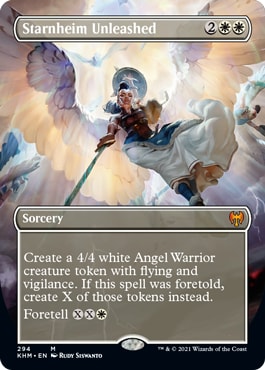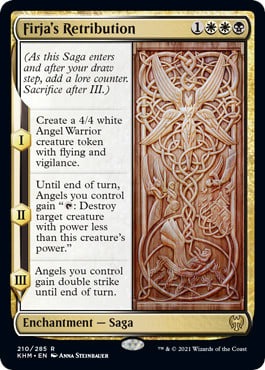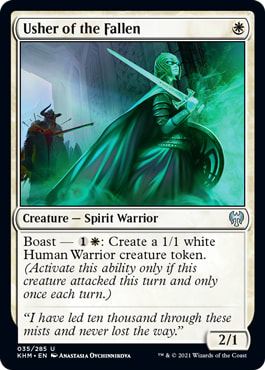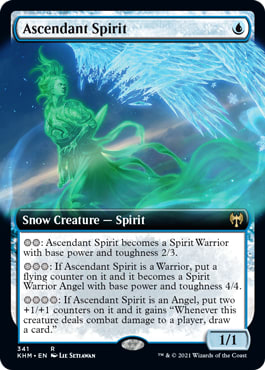At the height of Ravager Affinity I made a Standard Mono-Blue deck that I really liked. The first one with Keiga, the Tide Star and Meloku, the Clouded Mirror. I liked it so much that I hopped on a plane to try my hand in the Standard Last Chance Qualifier at Pro Tour Columbus.
I missed.
I mean it was a near miss (both of the guys I lost to ended up qualifying)... But a miss it was. However, I had even better tech than main-deck March of the Machines in a room full of Great Furnaces. My friend Brian Kibler told me he was going to show up for two Pro Points but was leaving early to LARP as a Lyger (or was it a Tygon?) in the Appalachian wilderness somewhere: So, there would be a gap on the Sunday announce team.
Filling that spot was a heck of a consolation prize and I ended up spending the better part of the next year or two calling Top 8s. Which was weird because I was trying to be a PT player at the same time, but still fun and I learned a lot.
Coverage announcers are probably not supposed to play favorites... But we all have them. You spend time following guys - especially watching particular ones grow - week in and Pro Tour out, and you're going to develop an attachment to one or two. For me, my favorite story arc superstar was Kenji Tsumura.
Kenji absolutely killed it on the Pro Tour almost every time I was in the booth. He lost the Psychatog mirror to French Hall of Famer (and eventual LA Champion) Antoine Ruel in what would be my favorite call of all time. Just prior to that he came an inch away from capturing the Philadelpha Skins Game. But before either Top 8 Kenji got on my Coverage narratives radar by securing Top 4 of Pro Tour Atlanta.
The fascinating thing was that Kenji's opponent was essentially locked for Top 4. In with a draw. If he just played at normal speed, he would be shuffling up on Sunday. I'm not talking about slow play or stalling... Just playing at a normal pace that, with time running down in a 1-1, would simply not result in Kenji winning the final game.
But Kenji forced his opponent to play at his speed. From a few feet away it almost looked like psychic puppetry. Not only making that bad attack into a Kami of False Hope sequence... But literally playing fast enough so his opponent could win. Prior to this the Japanese were largely respected for their technical skills - and boasting one Tsuyoshi Fujita - their deck design; but American players tempered at the poker table considered their mental games soft.
After Atlanta? No one ever decried a Japanese master's mental game again.
The funny thing is... Kenji didn't invent playing at different speeds, or forcing the opponent to play at different speeds. That honor belongs to maybe the most influential deck of all time, The Deck, and its legendary creator, Pro Tour Top 8 competitor Brian Weissman.
The Deck | December '95 | Weissman
- Creatures (2)
- 2 Serra Angel
- Instants (17)
- 1 Ancestral Recall
- 2 Counterspell
- 2 Red Elemental Blast
- 4 Disenchant
- 4 Mana Drain
- 4 Swords to Plowshares
- Sorceries (7)
- 1 Braingeyser
- 1 Demonic Tutor
- 1 Mind Twist
- 1 Recall
- 1 Regrowth
- 1 Timetwister
- 1 Time Walk
- Enchantments (2)
- 2 Moat
- Artifacts (11)
- 1 Black Lotus
- 1 Ivory Tower
- 1 Jayemdae Tome
- 1 Mox Emerald
- 1 Mox Jet
- 1 Mox Pearl
- 1 Mox Ruby
- 1 Mox Sapphire
- 1 Sol Ring
- 2 Disrupting Scepter
- Land (21)
- 4 Island
- 3 Plains
- 1 Library of Alexandria
- 1 Plateau
- 1 Underground Sea
- 2 Strip Mine
- 2 Volcanic Island
- 3 City of Brass
- 4 Tundra
- Sideboard (15)
- 1 Plains
- 1 Disrupting Scepter
- 1 Jayemdae Tome
- 1 Tormod's Crypt
- 2 Control Magic
- 1 Counterspell
- 2 Blood Moon
- 3 Circle of Protection: Red
- 2 Divine Offering
- 1 Moat
A year or two before the first Pro Tour Weissman and his friends figured out card advantage.
Can you imagine having "card advantage" before anyone else? It seems like having steel, or fire, in a world of chipped obsidian and spoiled ferret flesh. In order to get more out of card advantage and flex their ability to utilize it at the kitchen table, they collectively decided 20 life was simply not enough.
So, they played with double the normal amount of life in order to be able to explore their games. When they eventually started running the tournament tables they had to get their extra life some other way (like a first-turn Ivory Tower) but the concept stands.
At this point, the Sligh Mana Curve hadn't been invented yet, but people cloud string together a Dark Ritual and a Hypnotic Specter, or play Savannah Lions alongside White Knight. The obvious "fast start" strategies were known, so The Deck gained an advantage via its first enduring principle:
1. Be Capable of Playing at Different Speeds
The core strategy of The Deck was sequential. Basically, you did whatever you had to do with Swords to Plowshares and Counterspell to not die. Then you played out Disrupting Scepter. Then you bonked the opponent with it until they had no cards.
This could take a while in literal time, but opponents would quickly find themselves in a predictable spot. Use it or lose it.
Weissman could find his one Mind Twist (or later Amnesia) to get opponents to zero cards; keep hands locked with the Disrupting Scepter; and finally deploy Serra Angel (more on Serra Angel in a bit) for the win.
The presence of fast defensive cards like Swords to Plowshares, and broad sources of defensive card advantage like Moat forced opponents to develop more slowly than they would have liked in the abstract. This time was literally fuel for Weissman &co. Time they used to bonk out card advantage with Disrupting Scepter every turn, or draw cards themselves with Jayemdae Tome.
In the abstract The Deck was one of the slowest strategies in any room. But it didn't only have to play in the abstract. The Deck could play at different speeds.
What might Kaldheim successors to The Deck think about this?
How about playing with this new card? Cosima, God of the Voyage // The Omenkeel can help you play at least three different speeds by itself.
Imagine you played this card in a Yorion, Sky Nomad deck. While those decks have cool artifacts like Mazemind Tome to run on two... How about adding The Omenkeel as another two mana artifact?
You can play The Omenkeel on two... And then quickly crew it with the 1/1 tokens from Omen of the Sun!
Yorion decks already want to play Omen of the Sun due to the combination of defensive abilities + the prospect of a Yorion double-up. Peanut butter and chocolate on turns 2-3, am I right?
But Yorion doesn't have to stop at Omen of the Sun. You can also reset The Omenkeel!
Might you want a powerful and persistent source of creature-based card advantage? You're already playing Yorion, Sky Nomad, so I assume the answer is "yes." Yorion can play explosively... And it can also set up Cosima grinding from a previous identity as a 3/3 vehicle.
And, of course, you can just play Cosima on turn three. Whether you want to deter a Robber of the Rich or set up the Cosima grind "the old fashioned way" is up to you: Cosima fits right in, and - in one card - can allow you to meet the speed of beatdown, set up an excruciating long game against a fellow control player, or eke a little more value out of your already-valuable tools.
For The Deck, the ability to play at different speeds was largely dependent on...
2. Playing Serra Angel
Weissman and friends figured out card advantage before almost everyone else.
On top of that they figured out creatureless - or in this case, creature-poor - decks. There were creatureless variations on The Deck, pushing its core strategies even further with Jester's Cap exhaustion as the preferred kill. The first Pro Tour was won by a ![]()
![]() Millstone deck. Weissman himself experimented with Fireball and Mirror Universe.
Millstone deck. Weissman himself experimented with Fireball and Mirror Universe.
But the most famous and influential version of The Deck was the one with two Serra Angels.
Serra Angel itself was chosen carefully: It was a card that could both attack and defend simultaneously - due to vigilance. More importantly, it could specifically defend against creatures that could fly over the Moat. It was too big to Lightning Bolt off the top (when the opponent was otherwise locked by Disrupting Scepter). It was big enough to win a lot of fights.
Whatever creature they chose, the important thing was that this was a creature-poor NOT creature-less strategy. This allowed for some additional subtle advantages. The opponent's removal wasn't very good. But they might not be able to in good conscience side it all out. It was as good a way to win as any... And in desperate situations the ability to block was probably more advantageous that the ability to kill only, as with a Fireball or Jester's Cap.
But perhaps most importantly, The Deck could deploy Serra Angel early, prior to establishing a Scepter lock, if it was the right thing to do. This was a deck with Mana Drain, remember! It could get some extra mana to play out Serra Angel while leaving some open for the Counterspell to protect it. That way, especially if the opponent had sided down to very little creature kill, that poor-verus-less qualification could come to bite them.
In exactly five simultaneously defending swings.
Kaldheim has shockingly taken three different swings at the best creature of Magic's first age.
This card really pushes the envelope on a Serra Angel in my opinion.
On the one hand it is effectively a Serra Angel for one less mana. In my day we would sometimes concede substantial disadvantages (as with a Waterspout Djinn) in order to get a 4/4 flyer for four mana. This is a full-on Serra Angel at a discount.
If you stipulate the foretell downpayment, five mana version will get you two. I'm not sure if it's the Tap-Out Control half of me or the one that played Akroma's Vengeance and Decree of Justice at every opportunity that wants this card to be great more.
But I want it to be great.
I actually think this card could just be great... But only in a dedicated deck.
On its face, it's Serra Angel - a 4/4 flying vigilance - for the cost of a Serra Angel. But you get a tribal-specific Grave Pact along for the ride. If fair creature decks are a thing and Angels are a things, they intersect at this thing.
Is this actually the pushed version of Rampage of the Valkyries? A Serra Angel for the cost of... A Starnheim Unleashed? With two more chapters, including Vindicate chapter and Overrun chapter?
Whether Angels band together like the Victoria's Secret dressing room or it runs a singleton token game like Secure the Wastes sometimes did... I feel like Starnheim Unleashed can be successful either way. Rampage of the Valkyries is a little pricey to be on any other team. Firja's Retribution is not. It seems very likely to be good enough on its own. But if Angels is good? This card will be great.
What if all these cards are good enough? How many are you supposed to play? An Angels deck? I might not shake my fist at all twelve. A control deck though? What does The Deck say?
3. Compressing Your Tools Leaves More Room for Control Elements
Weissman's deck played exactly two Serra Angels. This was maverick for the time, though decks of later years have done all kinds of running just one Mahamoti Djinn (or Keiga, the Tide Star).
The theory is simple: If you don't want to play your finisher (most of the time, anyway) until the opponent is locked, minimize your chances of drawing it and you'll increase your chances of drawing something to keep you alive.
Kaldheim gives us a tool that echoes this spirit and does you one better.
I was initially lukewarm on this card.
I was wrong.
You can think about Niko Aris in three broad ways. You can compare them to X, you can compare them to Y, or you can talk about them just as themself.
First of all, there is Niko as the removal spell. For three mana you get a pretty serviceable Nekrataal. On turn three you can play Niko Aris, kill their X/2, and keep two loyalty. That's not bad. You can put more loyalty on Niko Aris and kill bigger things in the future. Or you can grind twice with them.
Then there is Niko Aris as a Jace Beleren. They both cost three. If you don't engage in any interplay, a three mana Jace Beleren will draw you - you specifically - three cards. So will Niko! You have to do a little work with Niko, but it's three cards for the same amount of mana. Jace Beleren was a Top 10 card in Standard, remember.
If you want to engage in a little interplay, Niko, like Jace, can do you better.
And then there is Niko... As Niko. Have a ton of mana? You can put it into Niko! What if you don't play them at three? What if they're part Nekrataal and you still grind with them? In the same game?
Now Niko Aris doesn't just draw extra cards: They deploy lots of enchantments that can help you draw extra cards. In this way, Niko echoes one of The Deck's strongest proactive dilemmas:
4. Tax Their Specific Removal Enough, And They Will Run Out of It
Now the opponent is going to have to be pretty desperate to want to use a Disenchant on your Shard, but it's in the range.
The Deck thrived, in part, on a parallel ability to tax Disenchant-type removal. Moat and Disrupting Scepter created a fork. Kill Moat and you're eventually going to be locked. Kill Disrupting Scepter and you're going to concede even more card advantage to your creatures sitting around doing nothing.
It's not that Lucky Clover was so much more busted than Edgewall Innkeeper (who can attack, trade, chump, and power up a Lovestruck Beast)... It's that Lucky Clover demanded specialized removal.
By playing a lot of artifacts and enchantments, The Deck's 2021 descendant can bedevil opponents and split their ability to interact. No one wants to Disenchant an Omen of the Sun that already got its money any more than a Shard token... But both are somewhere in the range. The Omenkeel on the other hand? Legit target, especially for decks that have sorcery speed sweepers or other removal.
But fighting The Omenkeel one-for-one is going to tax the opponent's ability to fight Mazemind Tome... Or even Glass Casket. Glass Casket on a token creature (which increasingly looks like it might be a 4/4 vigilance flyer) is card advantage itself when combined with a Yorion blink and a non-token target.
Finally:
5. Even When They Seem Off-Plan, Respect a Sick 1-drop
The Deck played Swords to Plowshares.
Very on-brand.
Nearly three decades later, Swords to Plowshares is still a Staple of White control decks in formats that are allowed to play it.
But Red Elemental Blast?
As we said, later builds of The Deck more centrally incorporated cards like Fireball (or Gorilla Shaman, or added Pyroblast)... But this early one played no other Red cards but Blood Moon in the sideboard.
Red Elemental Blast was an off-color splash at a time before fetchlands. It was a metagame call... That was spectacular when it was appropriate! Whether forcing through your key card with 1 mana or countering an opposing threat, Red Elemental Blast was about as awesome as it looks.
But still? Kind of off brand for a deck that's supposed to take on all comers... And a ![]()
![]() one at that.
one at that.
But it was just so good, yadda yadda yadda.
Kaldheim has got a couple of potentially off-brand 1-drops I just couldn't not mention.
I keep looking for the drawback. There isn't one.
Savannah Lions-plus?
You'll need to put your mana base through the paces a little to work this one... But if you do? It'll slide under Counterspell walls and run them over.
I'd say both of these cards are eligible for some sideboard space, maybe even a transformative theme...
But that's not a strategy that derives from The Deck.
LOVE
MIKE
































